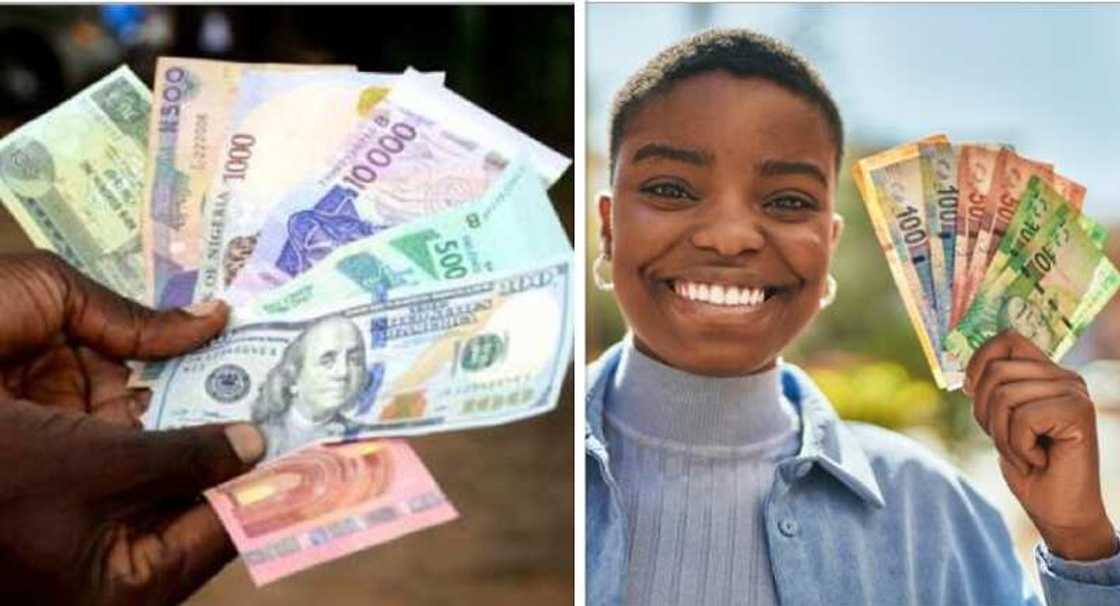Naira Not Among Top 10 Weakest Currencies in Africa as CBN Continues to Fight Depreciation
- Despite Nigeria's naira depreciation, it is not among the top 10 weakest currencies in Africa
- The Sierra Leonean's leone is the weakest currency in Africa and the fourth weakest currency in the world
- Foreign investors, tourists and governments of other countries are affected by a country’s currency movement
Unlock the best of Legit.ng on Pinterest! Subscribe now and get your daily inspiration!
The exchange rate is still a significant issue because it determines macroeconomic expansion. Its movement plays a vital role in defining trade and money flow dynamics and the decisions made by people, corporations, and the government.
Exchange rates also decide how much different currencies are worth compared to one another.
That said, Nigeria's naira appears missing from the top 10 list of weakest currencies following several initiatives and policies the Central Bank of Nigeria has applied to rescue the naira, including the recent unification of different exchange rates.
As international trade has grown significantly over the past few decades, affecting trade volume and the current account, the elimination of trade and policy obstacles has contributed to global trade growth.

Source: Getty Images
PAY ATTENTION: Сheck out news that is picked exactly for YOU ➡️ find the “Recommended for you” block on the home page and enjoy!
This has furthered the significant relationship between the exchange rate and global economic relations, making it one of the most closely followed globally.
Beyond local companies and governments, the effects of an unstable currency can affect visitors, foreign investors, and other governments. For investors hoping to profit from foreign exchange trading, changes in exchange rates can present a chance.
A greater currency value makes a nation's exports more expensive and imports less expensive in international markets, thereby worsening its trade balance.
Conversely, a lower currency value raises a nation's import costs while lowering its export costs on international markets, increasing its trade balance.
Nigeria and several other African nations have recently struggled with dwindling exchange rates caused by significant economic decisions. Notably, the most populous country in Africa does not even rank among the 10 nations with the weakest currency.
From the weakest 10, Legit.ng presents African countries with the weakest currency relative to the US Dollar according to data tracked by trading economics as of 18th July 2023.
1. Sierra Leone (1 USD = 19995.0 SLL)
According to Forbes, the Sierra Leonean's leone is the weakest currency in Africa and the fourth weakest currency in the world. The money was first introduced in 1964.
The West African nation, which borders Liberia and Guinea, exports timber and minerals like gold, diamonds, and industrial metals. More than 40% inflation, considerable debt, a slowdown in economic growth, and the long-term impacts of the Ebola crisis have all reduced the value of the leone.
2. Guinea (1 USD = 8509.00 GNF)
The Guinean franc is the second weakest currency in Africa. The money introduced in 1959 is ranked the eighth weakest currency globally.
Guinea is a former French colony in sub-Saharan Africa. The country has abundant natural resources, such as gold and diamonds. However, it has struggled with high inflation, military unrest and an influx of refugees from neighbouring Liberia and Sierra Leone.
3. Madagascar (1 USD = 4430.00 MGA)
Madagascar ariary is the third on the list of weakest currencies in Africa. The money replaced the Franc as the official currency on January 1st, 2005
India and East Africa are connected through the island nation of Madagascar. Due to its island status, Madagascar exports more than 25% of its GDP in primarily agricultural, forestry, and fisheries goods.
4. Uganda (1 USD = 3665.00 UGX)
The Ugandan shilling, first issued in 1966, ranks four on the list of weakest currencies in Africa, as shown by recent data.
East African landlocked nation of Uganda is bordered by the Democratic Republic of the Congo, South Sudan, Kenya, Tanzania, and South Sudan.
Oil, gold, and coffee are abundant in the nation, but its economy has been plagued by erratic economic development, significant debt, and political upheaval.
5. Burundi (1 USD= 2806.96 BIF)
The Burundian franc, an official legal tender in Burundi, is ranked no five on Africa’s weakest currency list. The country began issuing its franc in 1964.
Burundi is bordered on the southwest by Lake Tanganyika. It is surrounded by Rwanda to the north, Tanzania to the east, the Democratic Republic of the Congo to the west, and Tanzania to the east.
According to the World Bank, Burundi has a low-income economy and 80% of its people work in agriculture.
6. Congo 1 USD = 2476.00 CDF
The national currency in DRC is the Congolese Franc (CDF), created in 1997, replacing the Zaïre.
Mineral reserves are the principal economic resource of the nation; about 90% of exports are derived from mining.
More than three-fourths of the workforce is employed in agriculture, animal husbandry, fisheries, and forestry, generating more than two-fifths of GDP on average.
7. Tanzania (1 USD = 2440.00 TZS)
The Tanzanian shilling replaced the East African shilling on 14 June 1966.
A few key sectors of Tanzania's economy are tourism, mining, and agriculture. Despite employing the bulk of the population, just 25% of the country's GDP comprises the agricultural sector.
8. Rwanda (1 USD = 1159.60 RWF)
The Franc became the foreign money of Rwanda in 1916.
Rwanda is a heavily agricultural nation, with 70% of the population working in agriculture. The economy mainly depends on producing tiny, dispersed, semi-subsistence farms, and the principal exports are tea and coffee.
9. Malawi (1 USD = 1043.020 MWK)
The Kwacha has been the official currency in Malawi since 1970.
Since it is one of the least developed nations, Malawi's economy is primarily based on agriculture, and about 90% of its citizens reside in rural areas. About 40% of the GDP and 88% of export earnings come from agriculture.
10. South Sudan (1 USD = 979.067 SSP)
The Sudanese Pound is the currency of the Republic of Sudan and is issued by the Central Bank of Sudan, adopted when the country gained independence in 2011.
The country employs 80% of the labour force in agriculture, which also accounts for a third of GDP. However, since a large portion of this produce is subsistence farming, many people continue to live in poverty.
Source: Legit.ng


